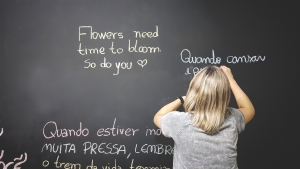Certain Spanish concepts can be confusing for beginners. Here, Carmichael, CA Spanish tutor Joan B. shares some effective exercises to master the basics of the Spanish language…
With lots of new concepts, words, and ideas, learning Spanish can be difficult for beginners. The following exercises will help you become more proficient with the building blocks of the language.
Practice these best Spanish exercises for beginners to feel more comfortable and confident speaking and writing in Spanish.
How Can I Learn Spanish at Home for Beginners?
If you want to learn a beautiful and useful new language, here are some free Spanish exercises for beginners:
- Do grammar and vocabulary exercises from workbooks – use a Spanish exercise book for beginners to get the right kinds of lessons
- Engage with Spanish media – read Spanish books , watch Spanish television, and listen to Spanish music
- Watch movies and television shows with subtitles
- Travel to Spanish speaking countries for a true immersion experience
- Find a native speaker to practice with
- Use flashcards
- Try a Spanish learning app
Of course, one of the best ways you can learn a new language – including Spanish – is to take language lessons with a talented teacher. You’ll learn all the important grammar and vocabulary you need to know, as well as things that are harder to pick up through typical online resources, like proper pronunciation:
5 Top Spanish Exercises for Beginners
We’ll go into more detail about some specific, targeted Spanish language exercises for beginners below, but if you’re looking for a quick fix, you’ll find that these Spanish exercises for beginners fit the bill perfectly!
1. Recite Verb Conjugations
Verb conjugation is one of the keys to speaking, reading, and writing in Spanish. When you can easily conjugate verbs with the different endings, -ar, -er, and -ir, you can say a lot of things and express a variety of ideas.
Choose a verb from each ending group, and recite the conjugations for different subjects. For example, conjugate caminar: camino, caminas, camina, caminamos, camináis, caminan. When you can recite the verbs in this way, you will have no problem remembering specific conjugations.
2. Repeat Subject Pronouns
It’s easy to confuse Spanish subject pronouns when you’re creating a sentence. Students often mix up he and she, or you all and them. Repeat the subject pronouns in order: yo, tú, usted, él, ella, nosotros, vosotros, ustedes, ellos. Then, repeat the pronouns and match them with various verb conjugations.
3. Identify Colors
Learning the colors in Spanish will enhance your vocabulary and help you be more descriptive while speaking or writing. All you need for this exercise is a magazine. Flip through the magazine and identify the items you know in Spanish. Say the word out loud, and then name the color. This is also a great way to practice agreement in Spanish, since the noun has to agree with the adjective in gender and number (una casa blanca, not una casa blanco).
4. Match Adjectives and Nouns
As you continue to learn Spanish, you should try to increase the complexity of what you’re able to express, so you can talk about interests, ideas, needs, and desires. Practice matching adjectives with nouns. This helps you describe the noun with more detail; it’s more descriptive to say “un muchacho bajo” than just “un muchacho.”
You can practice this by flipping through a book and choosing vocabulary, or you can use everyday objects that you know in Spanish. Then, pick an appropriate adjective to describe each object. This exercise also tests your ability to make the noun and adjective agree in number and gender (i.e. los escritorios pequeños, not los escritorios pequeña).
5. Write a Story
Understanding when to use ser vs estar is extremely important in Spanish. To practice this, write a simple story in English that uses the verb “to be” (I am, you are, he is, she is, we are, you all are, they are). Circle all the instances of “to be” in your story, and then decide whether you should use ser or estar in Spanish.
Write the correct conjugation of ser or estar above the English word. A good way to distinguish between the two is to ask yourself if the situation is referring to a temporary state, condition, or location. If you’re talking about a condition or location, you should use estar. Use ser if you’re describing things like origin, profession, dates, times, or traits.
How Can I Practice Reading Spanish?
If you want to practice your reading skills, these Spanish reading exercises for beginners should help you do so.
- Woodward Spanish – these reading passages focus on a specific topic and come with helpful vocabulary lists to reference as you read
- 123TeachMe – here’s another compilation of Spanish passages, all categorized by the level of difficulty
- Children’s Books Forever – you’ll find six downloadable Spanish books, complete with helpful illustrations
- GoComics – comic strips are always fun to read, and these take the enjoyment to the next (Spanish learning) level
- CNN in Spanish – this resource won’t be for the faint of heart – it’s an actual news website so you may encounter some tough Spanish vocabulary here
- Online newspapers in Spanish – MIT has a massive compilation of Spanish newspapers here, so you can brush up on your reading skills and current events at the same time!
- Duolingo app – you’ll find all kinds of resources for Spanish language learning, including those for reading help
- Langbox – here, you’ll find a selection of Spanish stories you can buy on Amazon
- Kindle App – you can look up “free Spanish books” and download more than 10 books on most days even without having a Kindle Unlimited membership
Spanish Translation Exercises for Beginners
All Spanish learners, from beginner to more advanced, can benefit from some Spanish translation exercises.
Here are some good ones to try:
- Oregon State University: illustrated recipes with food vocabulary
How Do You Practice Spanish Grammar?
Here are a few Spanish grammar exercises for beginners:
-
- SpanishDict’s Grammar Rules
- LivingSpanish.com
- Spanish Institute of Puebla’s Gramática Española
- “Uso de la gramática española avanzado” – this one example of a helpful Spanish grammar textbook you can use, with other options available here
- Todo Claro
- Trinity University’s interactive Spanish grammar exercises (best for those who are more advanced)
- The Herramientas de Español Online Textbook
How Do I Practice Listening Comprehension in Spanish?
These Spanish listening comprehension exercises for beginners should have you speaking fluently in no time. Here are some websites with lots of different Spanish listening comprehension exercises:
- SpanishListening
- SpanishPod101
- FluentU
- University of Texas’ Spanish proficiency exercises
- Gritty Spanish – great for learning the fine art of Spanish cursing!
- LingQ
- StoryLearning Spanish
- LdeLengua
- Telemundo videos
You’ll find more Spanish learning videos and exercises here.
How Do You Practice Writing in Spanish?
Last but not least, writing. These Spanish writing exercises for beginners are creative and fun, helping you learn how to write fluently in Spanish as quickly as possible. Here are some ideas to practice writing in Spanish:
- Start a blog – WordPress, Tumblr, and Blogger all have features that make it possible to produce polished Spanish blogs
- HelloTalk – this multimedia messaging service makes it easy for you to chat with fellow Spanish speakers around the world
- Social media – you can change the language on platforms like Facebook, Pinterest, and Twitter with ease
- Write everyday lists and notes in Spanish – when you make your grocery list, for example, try doing it in Spanish instead of in English!
- Use Google Translate to help you figure out exactly what to say when you’re feeling stuck
- Pen a journal or diary – but do it in Spanish
How Should a Beginner Speak Spanish?
These Spanish exercises for beginners should help you become more comfortable speaking and writing in Spanish. With regular Spanish lessons and practice, you’ll be well on your way to mastering the Spanish language.
Of course, one of the best ways for a beginner to learn how to speak Spanish is to take lessons with a qualified instructor. Sign up for Spanish lessons today – you’ll get access to the best Spanish exercises for beginners online!
 Joan B. lives in Carmichael, CA and has been teaching high school Spanish for more than 18 years. A lover of language, she’s studied French, Arabic, and Italian and spent time living in Spain. Joan aims to help students improve on tests and increase their conversational ability when traveling to Spanish-speaking countries. Learn more about Joan here!
Joan B. lives in Carmichael, CA and has been teaching high school Spanish for more than 18 years. A lover of language, she’s studied French, Arabic, and Italian and spent time living in Spain. Joan aims to help students improve on tests and increase their conversational ability when traveling to Spanish-speaking countries. Learn more about Joan here!
Photo by Alba Estevez
Maile Proctor










